Liz Glynn: No Second Troy
January 21 – March 23, 2012
Curated by Ciara Ennis
Pitzer Art Galleries, Pitzer College
60 pages, with color reproduction
ISBN: 978-0-9829956-3-1
Essay by Thomas Lawson and Ciara Ennis
Interview by Liz Glynn and Mark Allen
Edited by Susan Warmbrunn
Catalogue designed by Gabriela Contreras
Vanitas
Emerging Artist Series #6: Matthew R. Ohm
January 21 – March 23, 2012
Lenzner Family Art Gallery
Why are there trees I never walk under but large and melodious thoughts descend upon me?
— Walt Whitman, Song of the Open Road
The work of Chicago-born but now Long Beach-based artist Matthew R. Ohm focuses on our interactions with the natural world and our need to measure, regulate, possess, and control it.
The centerpiece of Vanitas is a large installation of whitewashed tree branches suspended above the viewer’s head, casting multiple shadows upon the walls of the gallery. The artist reassembles the discarded limbs, leftovers from the pruning of trees, in a renewed, if fictive, landscape––creating a memento mori to, and from, the dead branches. The installation transforms the gallery into an environment that references the natural world through a theatrical distillation: nature as hunting trophy. The shadows created by the suspended branches echo the former living plants but only as ghosts. They appear on the walls like a macabre William Morris decorative device, a sepulchral swag. Further pruning levels all the branches to create a flat plane overhead thus lowering the ceiling and enlarging the audience to a domineering scale in relation to nature.
The transforming of trees into skeletal clouds is an absurdist gesture but, arguably, an ad rem response to our abusive stewardship of this planet. With public water sources being sold to private corporations in order that we may purchase, at inflated rates, that which formerly belonged to us; and our relentless encroachment upon, and devastation of, open lands to make room for urban sprawl housing and the raw materials to construct it; is it any wonder that such a fever of willful self-destruction should prove contagious? Mr. Ohm’s editorial environmentalism presents us with such a poetic vision of ecological squalor that we hunger for the next chapter in the serialization of our collapse.
Matthew R. Ohm received his MFA from California State University, Long Beach in 2009. Ohm, an artist, sculptor and woodworker, has participated in numerous solo exhibitions including, A Majestic Oak Is Just A Crazy Nut Who Stood His Ground at Marilyn Werby Gallery in Long Beach, CA (2009); Trying to Bring the Dead Back to Life at Max L. Gatov Gallery in Long Beach, CA (2007); and Sticks & Stones at Marilyn Werby Gallery in Long Beach, CA (2007). He has also participated in numerous group exhibitions including, Off the Wall at Palos Verde Art Center in Palos Verde, CA (2011); Anarchy at Post Gallery in Los Angeles, CA (2010); Sub-Transient (collaborative show with Tyler Ferreira) at Arts Visalia Gallery in Visalia, CA (2009); Insights 2009 at the University Art Museum in Long Beach, CA (2009); Foehn Documents at The Constant Gallery in Los Angeles, CA (2008); CSULB Six Pack at the Tahoe Gallery in Incline Village, NV (2007); and The Grand Design at Hokin Gallery in Chicago, IL (2006). Ohm has co-curated Hysteria Updated at Max L. Gatov Gallery in Long Beach, CA (2008), Polytheism at Hokin Gallery in Chicago, IL (2005) and White at Little Known Gallery in Chicago, IL (2004). He was the visiting artist at Sierra Nevada College in Incline Village, NV in 2007. Matthew R. Ohm currently lives and works in Long Beach.
Contributing Writers
Mark Allen is an artist, educator and curator based in Los Angeles. He is the founder and executive director of Machine Project, a non-profit performance and installation space in Los Angeles. Machine Project also operates as a loose confederacy of artists producing shows at locations ranging from beaches to museums to parking lots. Under his direction Machine Project has produced shows with the Los Angeles County Museum of Art, the Museum of Contemporary Art in Denver, the Contemporary Art Museum St. Louis in Missouri, and the Walker Museum in Minneapolis. He has produced more than 500 events in Los Angeles at the Machine Project storefront space, and recently concluded a yearlong artist residency addressing topics of public engagement at the Hammer Museum in Los Angeles. Allen has taught at the California Institute of the Arts and the University of California San Diego, and is currently an associate professor of art at Pomona College. He serves on the Board of Directors of the Andy Warhol Foundation for the Visual Arts in New York and on the Advisory Board of the Center for Integrated Media at the California Institute of the Arts in Los Angeles. Allen received his MFA from the California Institute of the Arts following a residency with the Core Fellowship of the Museum of Fine Arts in Houston.
Thomas Lawson is an artist with a diverse, project-driven output that encompasses painting, writing, editing, curating and teaching. He has been showing paintings and developing temporary public works internationally since the late ʼ70s. Lawson was one of three selectors of the British Art Show in 1995. In the spring of 2009, selections from his older works were included in historical survey shows of the ʼ80s at the Metropolitan Museum of Art in New York and at Le Magasin – Centre National d’Art Contemporain in Grenoble, France. His essays have appeared in Artforum and other art journals, as well as many exhibition catalogues. From 1979 until 1992 he, along with Susan Morgan, published and edited REAL LIFE Magazine. From 2002 until 2009 he was co-editor of Afterall Journal. In 2010 he launched www.eastofborneo.org, an online magazine and archive. A book of selected writings, Mining for Gold, was published by JRP-Ringier, Zurich in 2005 and an anthology of REAL LIFE Magazine was published by Primary Information, New York in 2007. Lawson has received support from the Guggenheim Foundation and the National Endowment for the Arts. He has been Dean of the School of Art at the California Institute of the Arts since 1991.
Related Events
Opening Reception: Saturday, January 21, 2 – 5 pm
Artist Lecture: Monday, January 30 at 9 am
No Second Troy
Liz Glynn
January 21 – March 23, 2012
Nichols Gallery
Curated by Ciara Ennis
When a labor shortage threatened to derail its miraculous economic engine (the capitalist workforce was virtually cut in half by the Berlin wall) West Germany imported thousands of Turkish gastarbeiter, guest-workers, during the 1960s and 70s. A very different commodity, however, was similarly imported in the 1860s and 70s: the treasure of Troy. Bookended by these two events Los Angeles-based artist Liz Glynn has created No Second Troy, an exhibition featuring installation, video, and photographic works that examine the ideas of fable and obsession, desire and displacement.
Liz Glynn’s No Second Troy includes video documentation of interventions staged at archaeological sites around Turkey and crudely made but preciously embellished artifacts based on the infamous Prium’s Treasure—jewels, goblets, vases, weapons and plates made from copper, silver and gold—excavated at Troy, by amateur archaeologist Heinrich Schliemann. Fabricated from trash and re-cast in gold-plated silver and bronze, Glynn’s replicas allude to both the real artifacts as well as the copies commissioned by the Pergamon Museum in Berlin that, in another purloining, were confiscated by the Red Army in 1945. Other works in the series are based on the material culture of Turkish emigrants—foods, crockery, and other consumer goods purchased from local Berlin markets—referencing both the everyday life of Turkish emigrants and the copies of Turkish treasure regularly displayed in museums.
Glynn’s practice frequently uses ancient references to explore human agency and the potential for change in the present. This exhibition represents her first major attempt to link ancient contexts directly with contemporary material culture and the occasionally disjunctive nature of this relationship.
About the Artist
Liz Glynn received her MFA from the California Institute of the Arts in 2008 and a BA from Harvard College in 2003. Glynn creates large-scale installations and participatory performances using epic historical narratives to explore the potential for change in the present tense. She has participated in numerous solo exhibitions including: Loving You is Like _ _ _ _ _ _ _ the Dead, MOCA: Engagement Party at MOCA in Los Angeles, CA (2011); Alexandria and Other Losses at the Los Angeles Public Library in Los Angeles, CA (2011); III, produced by Redling Fine Arts in Los Angeles, CA (2010); Out of the Forest & Into the Light at Machine Project & the LA Opera Ring Cycle Festival in Los Angeles, CA (2010); California Surrogates for the Getty at Anthony Greaney in Boston, MA (2010); and The 24 Hour Roman Reconstruction Project at Arthouse at the Jones Center in Austin, TX (2009) and at Machine Project in Los Angeles, CA (2008). She has also participated in numerous group exhibitions including: Temporary Structures: Performing Architecture in Contemporary Art at the deCordova Sculpture Park and Museum in Lincoln, MA (2011); On Forgery: Is One Thing Better Than Another? at LA><ART in Los Angeles, CA (2011); No Swan So Fine at Michael Benevento in Los Angeles, CA (2011); 7 Sculptors at Brennan & Griffin in New York, NY (2011); Sculpture at Paula Cooper Gallery in New York, NY (2011); The shortest distance between 2 points is often intolerable at Brand New Gallery in Milan, Italy (2011); Let Them Eat LACMA at the Los Angeles County Museum of Art in Los Angeles, CA (2010); The Elysian Park Museum of Art at LACE in Los Angeles, CA (2010); Projects and Assignments at Saprophyt in Vienna, Austria (2010); The Generational: Younger than Jesus at the New Museum in New York, NY (2009); and Bellwether at Southern Exposure in San Francisco, CA (2009). She will also be participating in the Getty Museum’s Pacific Standard Time Performance Art and Public Art Festival in 2012. Glynn was awarded the California Community Foundation Emerging Artist Fellowship in 2010, the Joan Mitchell Foundation Associate Artist Fellowship in 2007 and the Alfred Alcaly Prize in 2004. Reviews of her work have appeared in the New York Times, New York Magazine, the Los Angeles Times, Art Lies, Domus, Archaeology Magazine, and artforum.com. Liz Glynn currently lives and works in Los Angeles.
Related Events
Opening Reception: Saturday, January 21, 2 – 5 pm, Nichols Gallery, Pitzer College
Artist Walkthrough: Saturday, January 21 at 2:30 pm, Nichols Gallery, Pitzer College
Artist Lecture: Monday, February 20 at 9 am, Nichols Gallery, Pitzer College
Panel Discussion: Tuesday, March 27 at 4:00 pm in the Broad Performance Space, Broad Center, Pitzer College with artist Liz Glynn, Michelle Berenfeld, professor of classics at Pitzer College and writer Andrew Berardini.
Catalogue: Synthetic Ritual
Synthetic Ritual
September 28 – December 09, 2011
Curated by Gabi Scardi and Ciara Ennis
Pitzer Art Galleries, Pitzer College
75 pages, with color reproduction
ISBN: 978-0-9829956-2-4
Essay by Jennifer Doyle, Gabi Scardi and Ciara Ennis
Edited by Andrew Bond
Catalogue designed by Stephanie Estrada (pdf)
Participating Artists
Mounira Al Solh, Meris Angeoletti, Beatrice Catanazro, Marcus Coates, Joel Kyack, Lawrence Lemaoana, Yoshua Okon, Adrian Paci, Marco Rios, Kara Tanaka, Carlin Wing, Amir Yatziv
Synthetic Ritual
September 28 – December 9, 2011
Nichols Gallery
Curated by Gabi Scardi and Ciara Ennis
Participating Artists
Mounira Al Solh, Meris Angeoletti, Beatrice Catanazro, Marcus Coates, Joel Kyack, Lawrence Lemaoana, Yoshua Okon, Adrian Paci, Marco Rios, Kara Tanaka, Carlin Wing, Amir Yatziv
Synthetic Ritual brings together a number of Los Angeles and international contemporary artists working in a variety of media including installation, drawing, performance, and video. The artists explore the idea of ritual as a faith-based activity that can be validated only within certain contexts—for example sport, religion and artistic practice—and cannot be rationally proven or substantiated.
The exhibition examines the presence of ritual and superstition in our professional and personal lives and asks why, in such an advanced and sophisticated technological and cyber driven world, ritual still occupies such an important and dominant role. Exploring the three central themes of ritual in relation to sport, religion, and artistic practice the artists provide refreshing and surprising commentary on ritualized behavior in the 21st century.
Elaborate ritualized behavior by sports fans and players dominates the world of sport. Whether it involves wearing the same unwashed jersey throughout the season, sleeping with a baseball bat to overcome a hitting dry spell, boxers drinking blood before a prizefight, repetitive rituals performed by baseball players with their gloves or feet before stepping into the batter’s box, fishermen avoiding the path of barefoot women, all of these behaviors are regarded as acceptable decorum; yet when isolated and examined, free from the clutter of a falsely normalizing setting, they are utterly absurd and hardly distinguishable from madness.
Similarly, sociocultural practices such as occultism or Freemasonry—as well as more conventional religions like Christianity or Buddhism—are sheathed in secrecy and cryptic codes, and all require adherence to specific practices and costumes. Whether it is transubstantiation or reincarnation, each has its own particular set of rules and fantastic belief systems that require faith in the irrational and the unproven.
Tic disorders, obsessive-compulsive behavior, and repetitive involuntary movements have legitimate expression in many artworks today. Examples abound, this century and last, in expressionism, abstraction, conceptual, pop and performance, and can be seen in work as far apart as Roman Opalka’s mapping of numbers one to infinity and John Bock’s Paul McCarthy-inspired deranged personae performances. Whether artists are using these “syndromes” as systems to make the work—process, series, repetition—or evoking these states to call attention to social/political/cultural aspects, the list of artists is extremely long and likely to grow.
Common to all these practices and activities—whether athletic, religious or artistic—is their reliance on behavior that is obsessive, repetitive, irrational, and unsubstantiated. The work of the artists in Synthetic Ritual all reference or employ some form of ritualistic behavior that, if taken out of the context of art, would be regarded as aberrant and unstable.
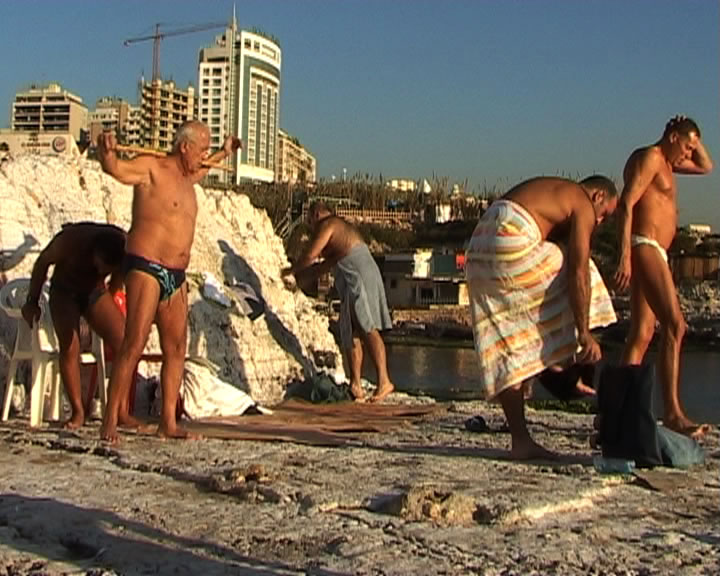
Mounira Al Solh (b. Beirut, Lebanon lives and works in Beirut)
Mounira Al Solh’s The Sea is a Stereo (2007-ongoing) documents the daily swimming habits of a group of middle-aged Beirut men, who regardless of circumstance—turbulent weather or bombing raids—are compelled to swim in the sea at the same spot everyday. With the backdrop of incessant violence and interminable conflict, their rigid swimming ritual becomes an act of defiance in the face of the uncertain and chaotic times and creates unity among them. [clear]
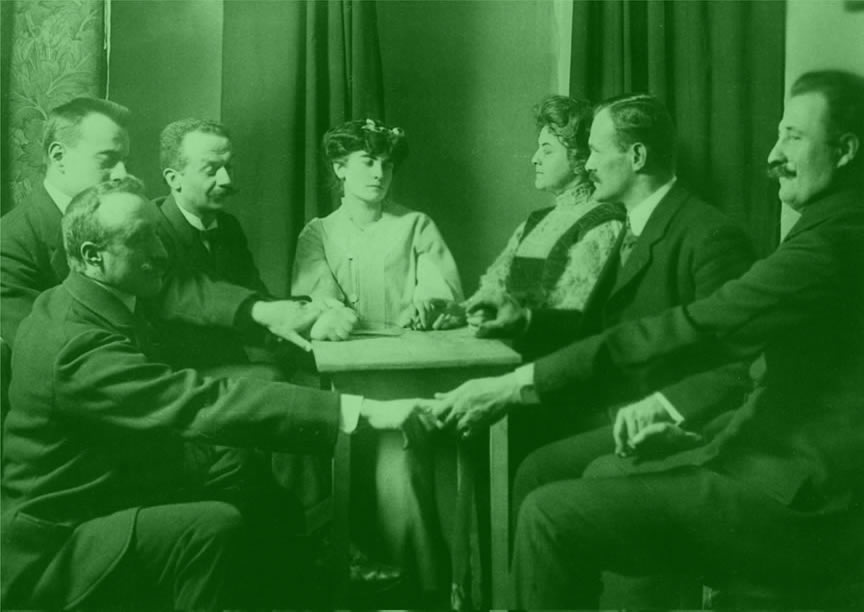
Meris Angioletti (b. Bergamo, Italy, lives and works in Paris and Milan)
Meris Angioletti models her practice on the methodologies and procedures of a detective, psychoanalyst and historian, allowing her to assume a number of different roles and experiment with diverse strategies. The video installation I describe the way and meanwhile I am proceeding along it (2009) examines the highly influential 19th century abstract painter, mystic, and suffragette Hilma af Klint. [clear]
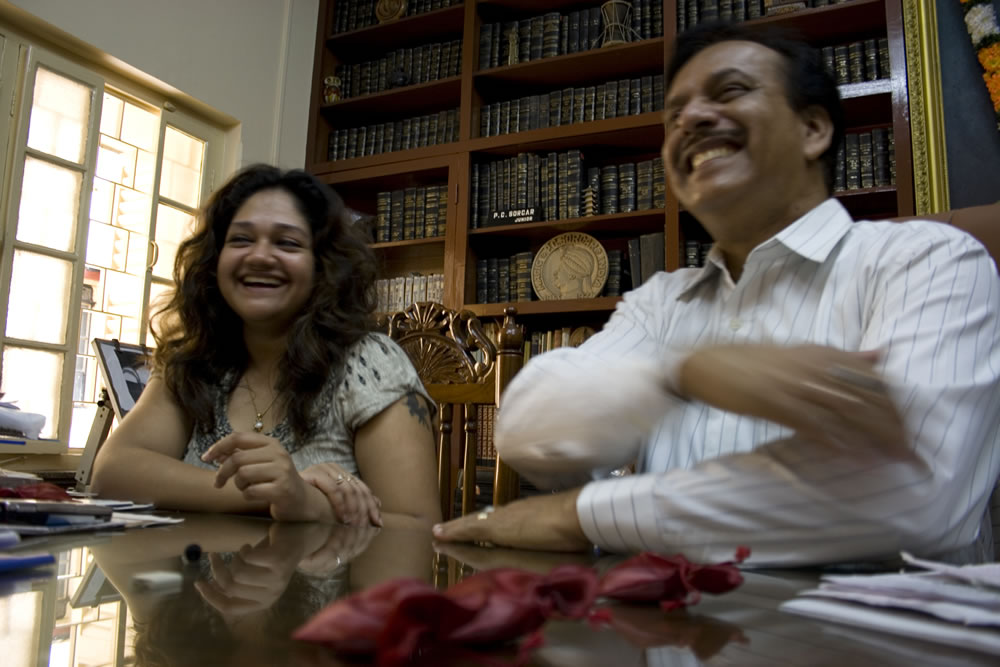
Beatrice Catanazro (b. Milan, Italy, lives and works in Milan)
The Water was Boiling at 34º 21′ 29” S, 18º 28′ 19” E, (2008), is a video work which takes the form of an interview between the artist and P.C. Sorcar JR—one of the most celebrated magicians in India—about the legendary “vanishing” of the Taj Mahal in Kachipura, Agra, on November 8, 2000. The work explores the possibility of employing magic and illusion to temporarily erase monuments and the narratives that they represent. [clear]
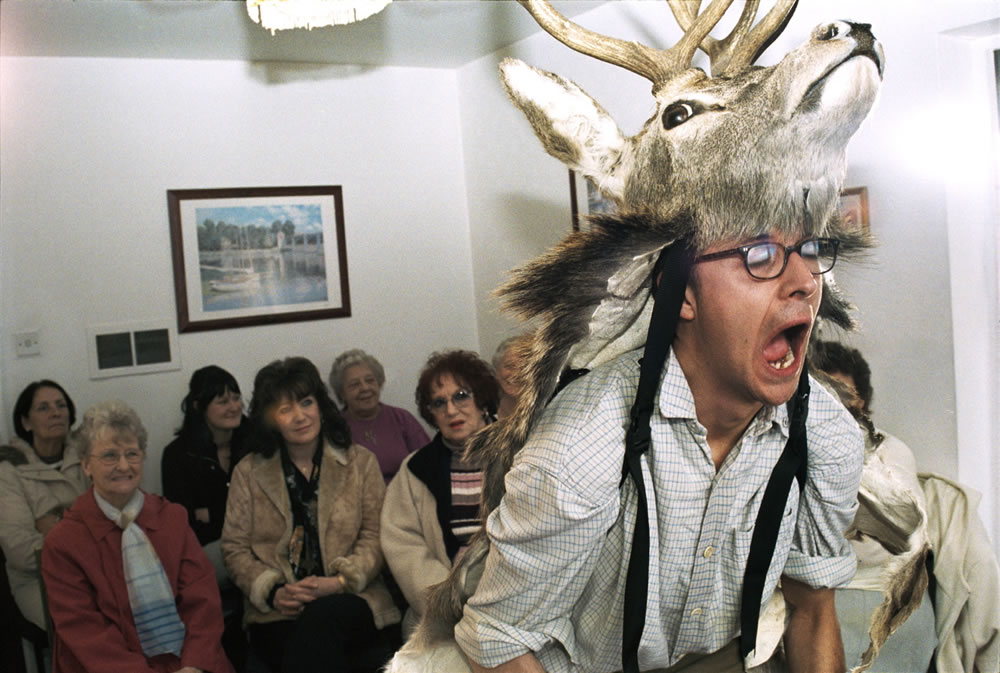
Marcus Coates (b. London, England, lives and works in London)
Investigating the relationship between shamanism and contemporary art, Marcus Coates’ dramatic and participatory events involve ritualized performances where he attempts to enter into the ‘lower world’ to communicate with spirits of dead animals. Journey to the Lower World (2004), documents one such ritual, which he performs wearing antlers and a reindeer pelt for a group of bewildered tenants from a condemned Liverpool housing estate. [clear]
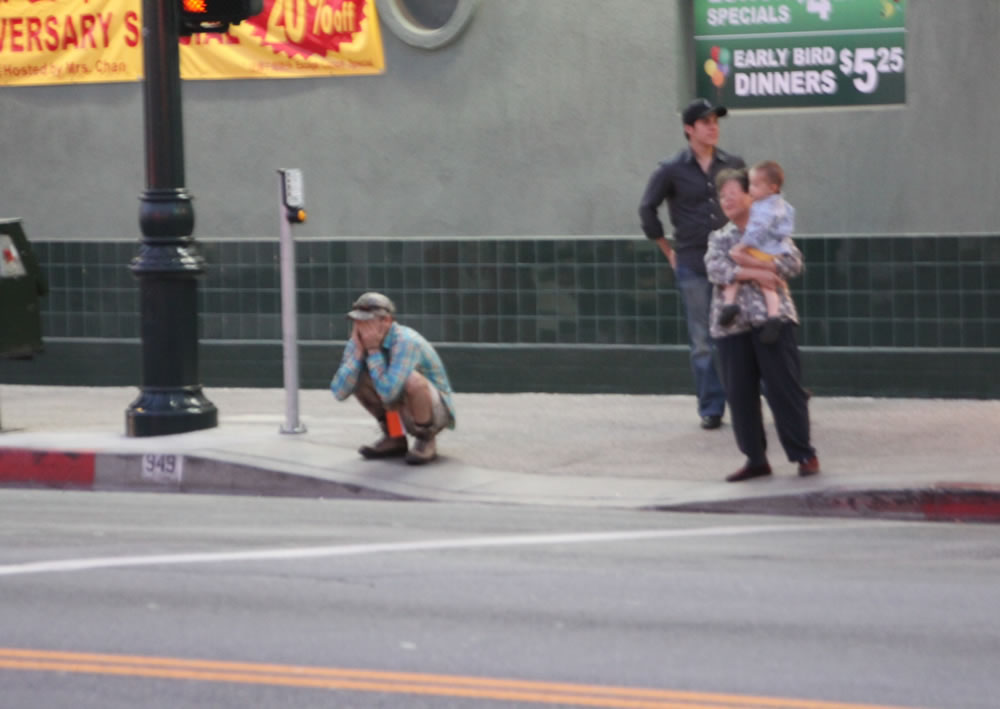
Joel Kyack (lives and works in Los Angeles)
LOCAL RECORDS is an ongoing series of projects where performance records are set in a specific site and community. These records are based around the number of times an action is repeated in a particular site over a 24-hour period. For Synthetic Ritual, Kyack will be performing a new Local Record live at Pitzer, in the 24 hours before the exhibition’s opening. [clear]
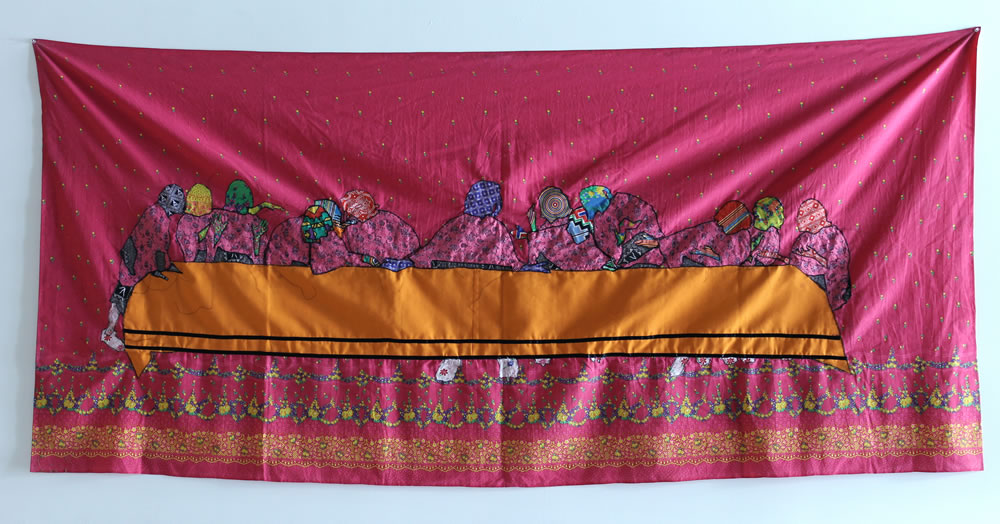
Lawrence Lemaoana (b. Johannesberg, South Africa, lives and works in Johannesberg)
Fortune Teller #5 (2008) and All Things Fall Apart (2008) explore the relationship between sport, spirituality and politics as well as role of the mass media in shaping the psyche in present-day South Africa. Using textiles employed by local sangomas, the cloth—imbued with great spiritual significance—lends authority to the embroidered text. [clear]
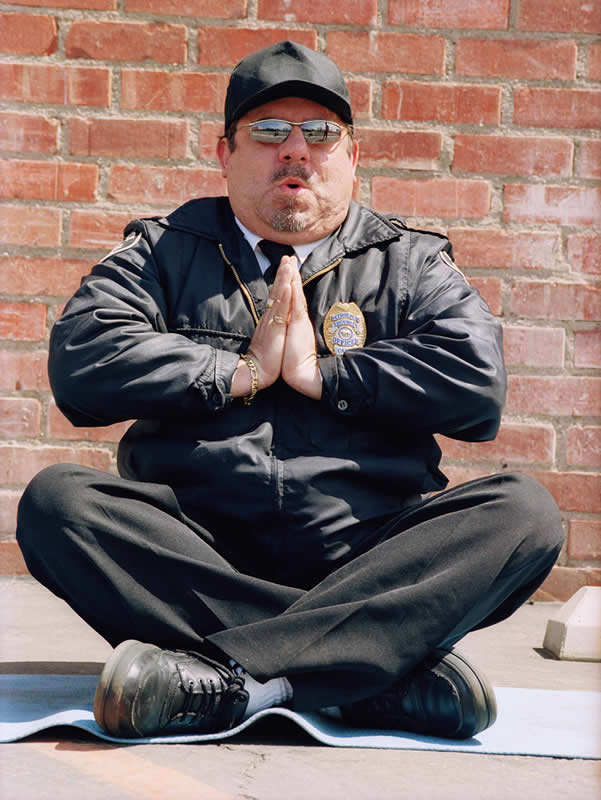
Yoshua Okon (b. Mexico City, lives and works in Los Angeles and Mexico City)
As with many of Yoshua Okon’s works, Parking Lotus (2001), an early photographic installation, combines humor with poignant social commentary. Installed floor to ceiling, the photographs depict security guards meditating in lotus positions in various parking lots around Los Angeles, and it is accompanied by the “Meditation Movement Manifesto”—a text supporting the spiritual welfare of security guards. [clear]
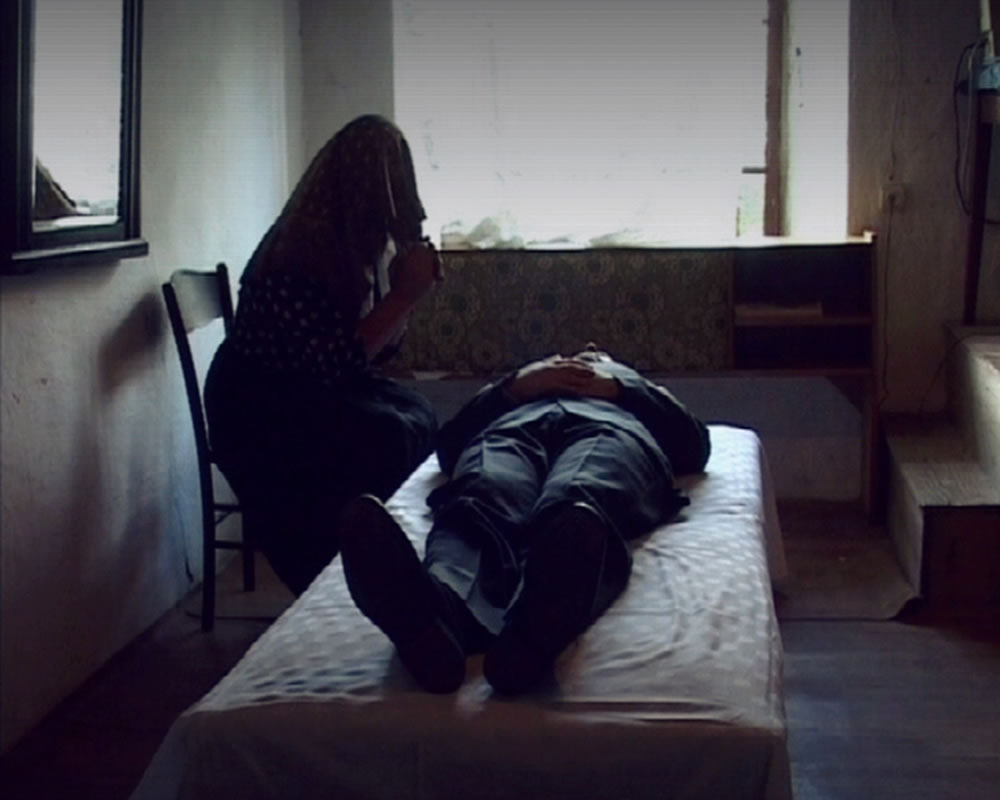
Adrian Paci (b. Shkoder, Albania, lives and works in Milan, Italy)
In Vajtojca (Mourner) (2002) Adrian Paci explores private and public mourning rituals. The video depicts a staging by the artist of his own death in his hometown of Shkoder, Armenia, where he was born. Employing a professional mourner, Paci is subjected to elaborate death rites and rituals while laid out on a table in a domestic setting. [clear]
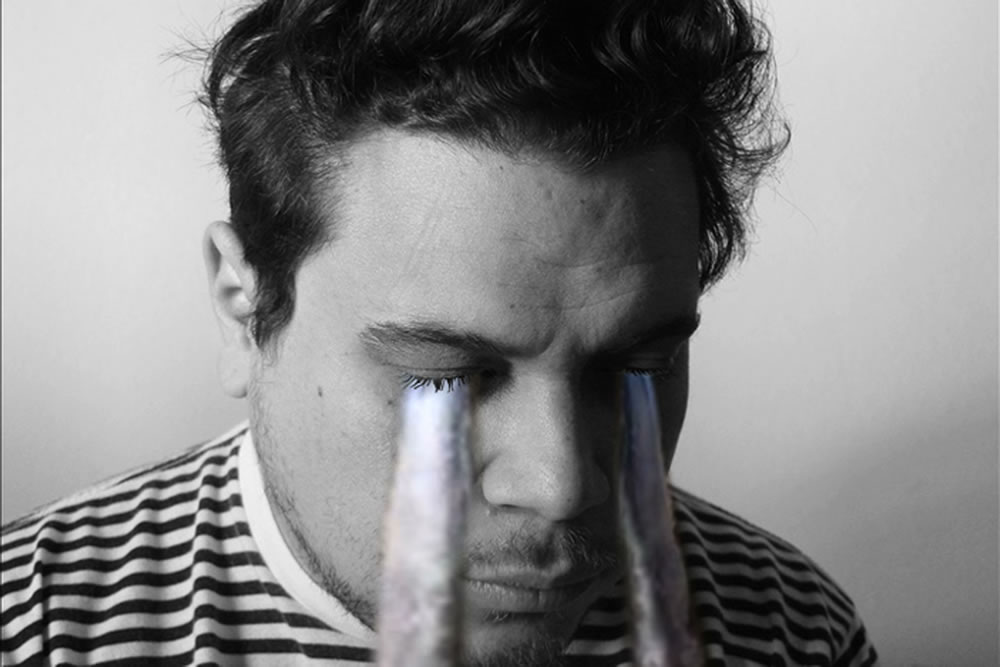
Marco Rios (b. Los Angeles, lives and works in Los Angeles)
Untitled (Weeping Video) (2010) is a large-scale video portrait of the artist with streaming waterfalls tearing from his eyes. The work reveals his larger preoccupation with psychological and emotional states, and the exaggerated use of art historical references. [clear]
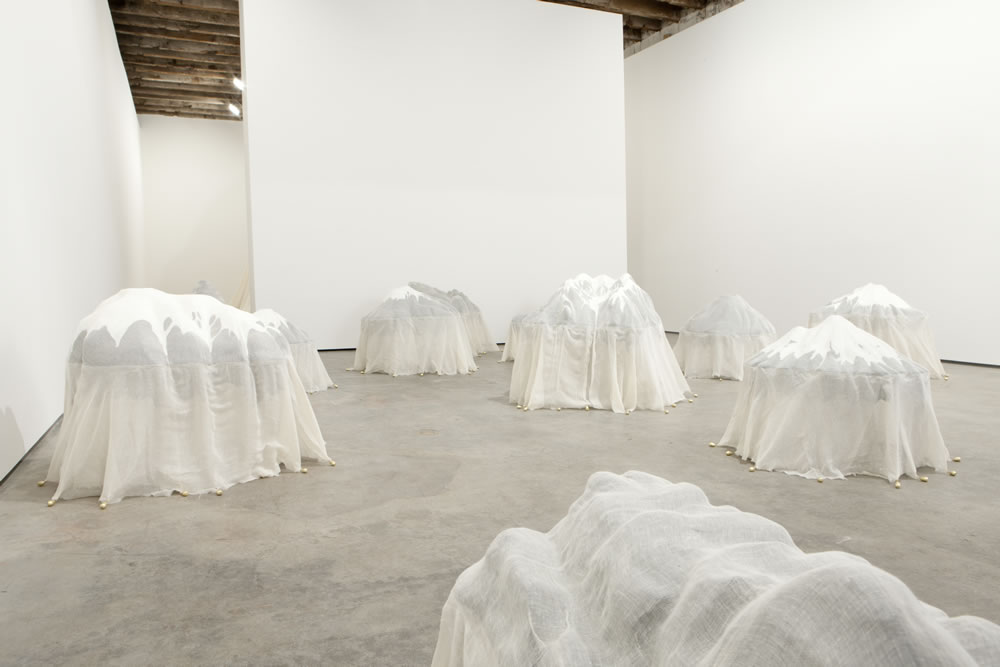
Kara Tanaka (b. Modesto, California, lives and works in Los Angeles)
The Hungry Human (Mountain Hunter) (2011) is a large sculptural installation depicting representations of sacred holy mountains found throughout the world, worshipped by pilgrims seeking enlightenment. Reflecting the larger history and conquest of these sacred sites, the work explores spiritual cultivation and the motivation for making grueling pilgrimages. [clear]
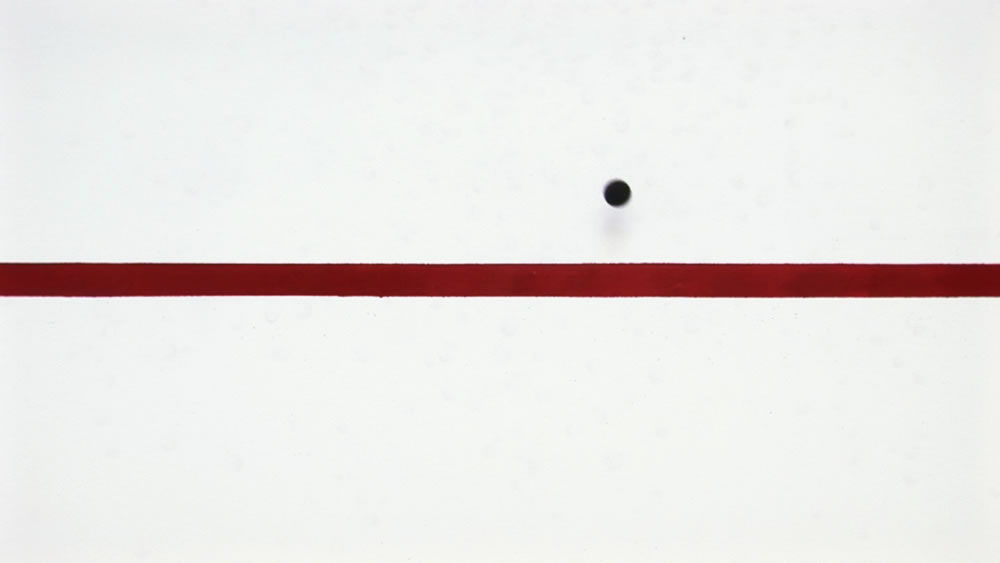
Carlin Wing (lives and works in New York)
Carlin Wing’s roles as both an internationally ranked squash player and a widely exhibited photographer come together in her series of video and photographic works Hitting Walls. Wing’s video-loop In the Eye of the Beholder (2009) records the moment when the ball hits either side of the central horizontal line, of the front wall of a squash court, with singular focus and stark economy. [clear]
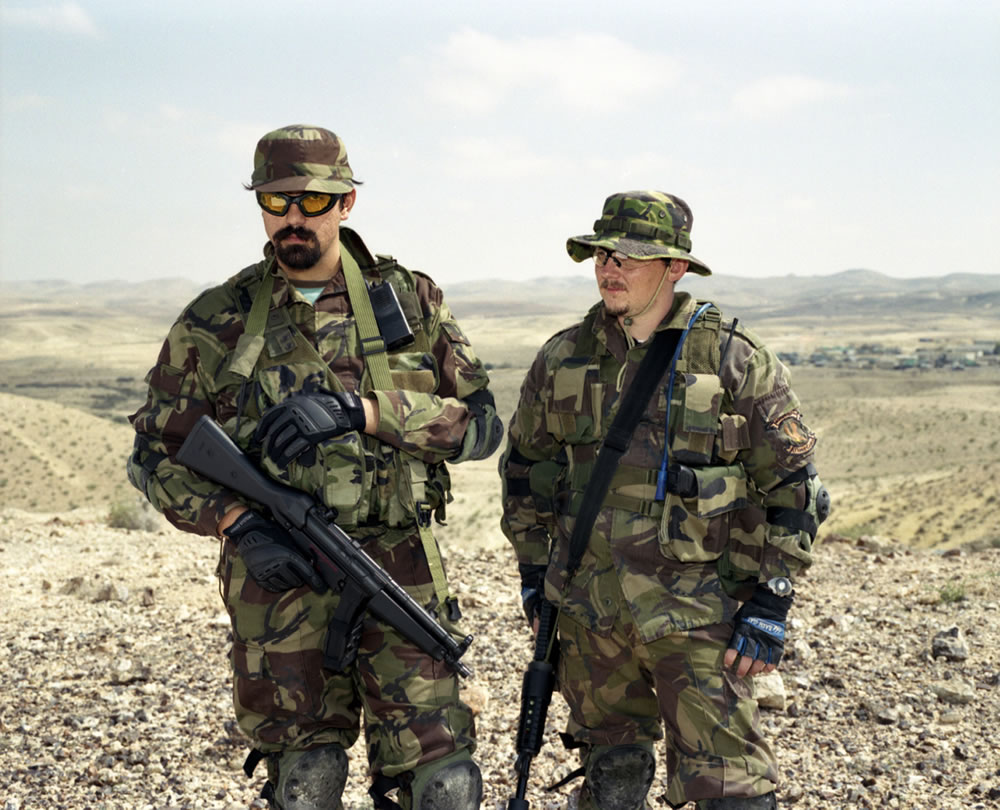
Amir Yatziv (b. Jerusalem, Israel, lives and works in Berlin, Germany)
Amir Yatziv’s Compressed Ceramic Powder (Battle in the Orchard) (2007) is a video installation featuring a group of young Israeli men solemnly describing their last moments in battle before death. This surreal adherence to the Israeli narrative of martyrdom is disturbed once it is revealed that the soldiers lost a paintball battle, not their lives. [clear]
Curator’s Bios
Gabi Scardi is an international curator and art critic based in Milan. She is a curatorial advisor for MAXXI (Museum of the 21st Century Arts) in Rome and co-curates CECAC (European Course for Contemporary Art Curators) – Fondazione Ratti, Como, Italy and Province of Milan. Between 2005 and 2009 she was the Contemporary Art Advisor to the Province of Milan . She has curated numerous exhibitions internationally including Aware: Art, Fashion, Identity at the Royal Academy of Arts in London (2010). At the Lyon Biennale in 2009, she organized T.A.M.A. – Project “Side Effect”, a collaborative project examining the situation of Romas in Europe. Her other projects include Yoshua Okón, Canned Laughter, Viafarini, Milan, (2009); Libia Castro & Òlafur Òlafsson, Riccardo Crespi Gallery, Milan, (2009); The Mobile Archive, Viafarini Care of DOCVA, Milan, (2009); Marina Ballo Charmet, Parco, Triennale, Milan, (2008); Stéphanie Nava, Considering a Plot (Dig for Victory), Viafarini, Milan, 2008, Alfredo Jaar, It is Difficult, Spazio Oberdan, Hangar Bicocca (2008), Debora Hirsch, BR-101, Fondazione Olivetti, Roma, (2008); LESS, Strategie alternative dell’abitare, PAC Padiglione d’arte Contemporanea (Pavilion for Contemporary Art), Milan, (2006), and LESS#1 Alternative Living Strategies, section of Gwangju Design Biennale (2007).
In addition, Gabi Scardi teaches courses on Contemporary Art and Public Art at Università Cattolica, Milan; Politecnico di Milano, Faculy of Design, Milan; Università Bicocca, Faculy of Sociologioy, Milan; Domus Academy, Milan; TSM – Trento School of Management, Trento.
Ciara Ennis is the director/curator of Pitzer Art Galleries at Pitzer College and was the curator of exhibitions at the University of California Riverside/California Museum of Photography, particularly of Still, Things Fall From the Sky (2005), Ruby Satellite (2006) and Eloi: Stumbling Towards Paradise (2007). Ennis moved from London to Los Angeles where she was project director for Public Offerings, an international survey of contemporary art, at MOCA, Los Angeles in 2001. From there she became associate curator at the Santa Monica Museum of Art, where she initiated the Project Room and programmed a series of experimental exhibitions with such artists as Urs Fischer, Simon Leung, Mark Leckey, Johan Grimonprez and Eduardo Sarabia. Ennis has been director of Pitzer Art Galleries for the past three years, during that time she has curated a number of exhibitions including: Antarctica (2007); Narrowcast: Reframing Global Video 1986/2008, co-curated with Ming-Yuen S. Ma (2008); Veronica (2009); and Capitalism in Question, co-curated with Daniel Joseph Martinez (2010). Ennis’s curatorial practice blurs fact with fiction and focuses on storytelling as a means to explore the fluidity and fragility of identity, revealing the subtleties of the social, political, and the cultural issues that impact our lives. She received her MA in curating contemporary art from the Royal College of Art, London
Related Events
Opening Reception: Wednesday, September 28, 5-8 p.m.
Curator’s Walkthrough: Wednesday, September 28, 5-6 p.m.
Artist Lecture: Pitzer Art Galleries in collaboration with Pomona College presents Joel Kyack
Wednesday, October 12, 2011, 1:30 – 3:00 p.m.
Lebus Court 113, Pomona College
PerpiTube
Repurposing Social Media Spaces
Co-curated by Pato Hebert and Alexandra Juhasz
July 12 – September 6, 2011
Nichols Gallery
PerpiTube: Repurposing Social Media Spaces, co-curated by Pato Hebert and Alexandra Juhasz, models a purposeful, complex, and artful use of social networking technologies and the spaces that hold them. In the gallery and on YouTube, this novel art show organizes the media of 29 invited participants along side the video production of daily visitors to the gallery, everyday YouTube users, invited community members, and you.
The Space is Now Open for All of Us. Together we will collaborate to rethink and remake liveness and delay, mobility and place, presence and absence, solitude and community, both online and off.
PerpiTube responds to many of the criticisms expressed by Juhasz and her Pitzer College students who tried to teach and learn on YouTube. Juhasz’s born-digital, free, online video-book, Learning from YouTube (MIT Press, 2011) was one end result of this immersive interaction, and PerpiTube is another.
Over two months, 29 diverse artists, activists, and academics will interact with audiences at the gallery—invited youth, community members, and educators, as well as daily visitors. Over the two months, a collection of their archived works (and your responses to them) will be available to many more on YouTube.
Each day at 10 am (PST time) the gallery will be open for a unique, fifteen minute, live, interactive event followed by fifteen minutes of refreshments and conversation. The next day, with only the smallest of delays, video documentation of the artist’s presentation and the audience’s response will be added to the exhibition’s growing archive.
For the rest of each day (10:30 am-4 pm) the gallery will be closed to live presentations and repurposed for videomaking and learning via two workstations: one for YouTube research and another for YouTube video production.
Los Angeles media artist, Natalie Bookchin, whose recent work has focused on YouTube, will present a video to open each of four themed sections based on chapters from Learning from YouTube. These themes will continue to be activated by invited participants—Italian exchange students, native California youth, women in a transitional facility, and local educators—who will attend Bookchin’s opening presentation and then a video workshop, and whose video will be placed into the show’s growing archive to kick off and expand conversation.
The unique structure of the show is designed to highlight how various spaces, on and offline, amplify the connections and contradictions between local place and digital mobility, the reception and production of social media, the tension between the ephemeral and the archive, and the “artist” and “amateur.” By so doing, the curators and participants model how social media, lived spaces, and their intentional interactions can be repurposed to empower users and communities by using digital technology in productive, intentional, and focused ways.
Exhibition Schedule
Distraction/Depth
Notes, Odd Lots, Restoration Selections, etc.
A Solo Exhibition by Kim Schoenstadt ’95
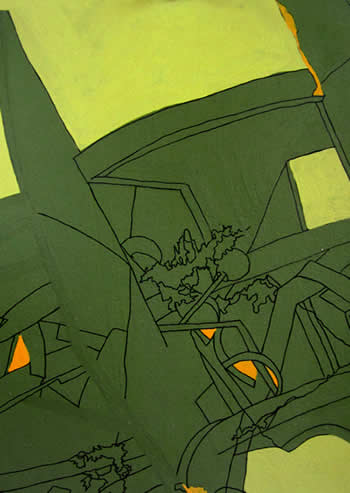
June 1-12, 2011
Nichols Gallery
Kim Schoenstadt ’95 is a visual artist who lives and works in Venice, CA. Her works have been featured in solo and group exhibitions in museums and galleries across the world.
In Notes, Odd Lots, Restoration Selections, etc., Schoenstadt merges the real with the imaginary. Blending diverse architecture from locations around the world, she creates a fusion of fresh styles that experiments with elements of existing architecture and virtual reality.
Related Events
Artist Talk with Kim Schoenstadt ’95:
During Alumni Reunion Weekend
Saturday, June 11, 2–3 p.m.
phenogenesis: Senior Art Exhibition 2011
phenogenesis: an evolution of expression
April 28-May 14, 2011
Nichols Gallery, Lenzner Family Art Gallery, Barbara Hinshaw Memorial Gallery
Lauren Conquist Anderson • Maia Ashkenazi • Casandra Campeas • Sophia Galano • Paula Gasparini De Oliveira Santos • Michelle E. Gross • Anja Hughes-Stinson • Evan Kelley • Sarah Lee • Avery Oatman • Morgan Pepper • Marita Pickron • Kamilla Q. Rifkin • Devin von Stade
Lauren Conquist Anderson
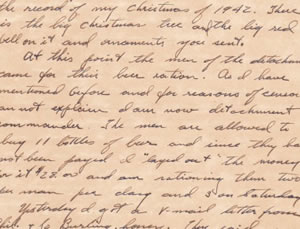
I find beauty in simple things: in magic and forts and confetti on a bad day; in children, and face paint, typography, and geography; in memories and mistakes. I collect images, scraps, and found objects from my daily life and incorporate them into my work as a reminder of a moment, a specific place, a collection of happenings. As my life has evolved, so too has my art. When I begin an artwork I am never exactly sure how it will end up. It is a process with unknowns and uncertainties, made up of mistakes and corrections. My work represents my journey: it is about the places and people who have touched me, where I have been, what I have gone through, and who I am because of it. I incorporate the scraps of life because I believe that trash can be treasure, that ambience can be art. I believe in creating work as a way to express yourself and share a part of who you are. I believe in using art as a way to cope with a sadness I do not always understand. This particular piece is about waiting. It’s about the not knowing, the loneliness and the pain, the uncertainty, the fear, and the hoping and dreaming of what is to come. Both of my grandmothers married my grandfathers before they deployed overseas for World War II. They waited four years for them to come home. And then I waited. [clear]
Maia Ashkenazi
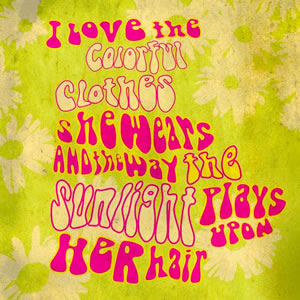
My work blurs the boundaries between form and function. To me, art and design are often indistinguishable, for both deal with composing something beautiful for a purpose, whether the purpose is aesthetic enjoyment, value, utility or conveying a concept or message. My artistic practice is currently wide-ranging, but my goal in the next few years is to narrow my focus. My previous work ranges from artist books and coffee table books, photography, colorful patterns, merchandise and advertising collateral, to found-object jewelry, mixed-media and digital collage, printmaking, painting and drawing. Common themes throughout my work are bright color harmonies, juxtaposition of detail with simplicity and contrast in value, shape and scale. My work shown in Phenogenesis is a series called “Womedia.” It consists of six cover artworks, one piece for each decade from the 1950s until today. Each piece in the series includes a few lines of lyrics from a song from that decade that address how women are represented or stereotyped within that decade. Each piece is displayed on the appropriate audio playback format for its decade. The aesthetic elements used within each piece draw from the visual style of each decade, yet the viewer should note the irony that these pieces were created today in order to look “vintage.” “Womedia” deals with women’s stereotyping issues in the media as well as misogyny in song lyrics in popular music within the entertainment and music industries. [clear]
Casandra Campeas
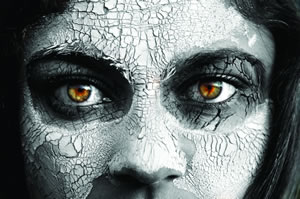
As a child, I knew photography was something I would love from the moment I picked up my mom’s camera. It didn’t become a passion until high school. My work stems from the interactions I have with my subjects and from my love for texture and detail. Like people, I believe ideas evolve into something unexpected. I enjoy creating an environment that is both a personal and comfortable space for the subject. I am drawn to small objects and enjoy exploring how light and color can add a transitional quality to black and white photography. Through digital photography, make-up and costuming, I examine the varied emotions that occur during a transitional period. I want to experiment with color while retaining the drama a black and white image has to offer. As time moves forward, the body evolves and inevitably deteriorates, through natural or unnatural causes. I picture this deterioration as a disease in itself, similar to the shedding of the skin. My goal is to express a kind of growth and decay through multiple textures and contrast. I want this decay, in part, to represent a resistance to evolution, a refusal to accept that time moves forward regardless of whether we are prepared. Each individual processes change in his or her own way. I believe accepting life changing events contributes to an evolution of the self. Change is inevitable and resistance towards it prevents the individual from moving forward and learning from past experiences. Some individuals focus on the excitement and embrace the journey. As I begin the next chapter of my life, I am joyful yet know it will be a struggle to let go of the past. [clear]
Paula Gasparini De Oliveira Santos (GDOS)
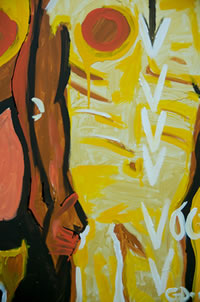
Letting Go.
(To Release, Relinquish, Unclasp, Withdraw, Unleash, To Bring Out)
To let go is to surrender and to give in to the forces beyond your control—surrendering does not mean to abandon or run away from what comes our way, but rather to immerse ourselves in everything without restraint. My work is the expression of how I live; it is effortless, though I do not mean easy, but rather without pain. I create images without regret or restraint and continually I paint over them. I value my paintings, but value the act of creation itself as paramount. Because life is transient, I let go of the permanence of images and instead recognize that it is the process of expression that remains with me eternally. My creations are free in form but are directed by an inner order and discipline—that of intuitive feeling. I drown my emotions in paint and words, so that I can free them. I let go in order to understand. My art is my self-expression—the symbols are personal but I share them and by doing so hope to inspire expression in others. I believe in the power of communication and unity, and the endless possibilities that can come from it. We were all born with the luxury of finding ourselves; I believe the power of expression is in all of us, children all over the world are proof. [clear]
Sophia Galano
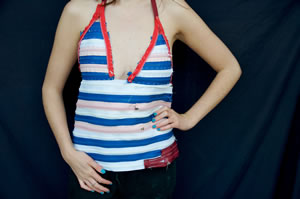
My senior thesis comprises three components using mixed media, wearable sculpture, fiber art and painting. The works are produced with unconventional materials and are constructed using traditionally “feminine” crafts such as knitting and sewing. Both the zipper and gown pieces are sewn by hand and machine, and are designed to fit my own body. The wire corset is knit on two different sized wooden needles, and can be adjusted by the back ribbons. These three works seek to question conventional ideas about femininity, domesticity, gender and sexuality. I am deeply influenced by artists exploring similar issues, such as Judy Chicago, Sharon Kagan, Annette Messager, Liza Lou and Cindy Sherman. My work also references historical symbols, such as the corset and formal gown. The zipper-halter-top strives to present a contemporary symbol of gender and sexuality. My artwork conceptualizes these issues through medium choice, subject matter and material. These works are not intended to fully reflect fashion or design, but instead meditate on aspects of gender and what it entails to be a woman. I did, however, choose the routine of dress and wearability as a means to contribute to the subject of gender. Throughout my career at Pitzer College I have attempted to explore this theme, and answer questions pertaining to gender for a young woman such as myself. These three pieces represent what I have learned in classes as well as in my everyday life. [clear]
Michelle E. Gross
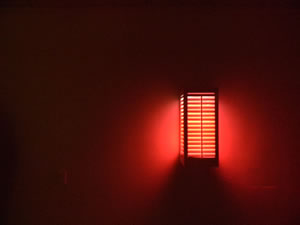
The works featured in the exhibition bring together and expose two of my obsessions within an aesthetic dichotomy: decrepit objects and light. I have been deeply inspired by the work of the Minimalist artists, Dan Flavin in particular. Flavin’s candid and innovative use of fluorescent lights challenged the formally dominant concept of a fine art medium. I admire other artists, such as Marcel Duchamp and Robert Rauschenberg, who likewise proved that even the detritus of modern existence could be art. Stylistically, my work shifts from the highly colorful and playful to work that is raw and unrefined. What excites me about used and found objects is that they are infused with an innate sense of nostalgia and history. Removing these objects from their utilitarian past and recontextualizing them into my pieces opens new lines of dialogue about function, design and art. I wanted to create an environment that evokes a different kind of perceptual experience from the one we encounter every day. The gallery space generated by my work is one where light, movement and perception combine to create a sensory experience that is enveloping and aesthetically perverse. I aspired to create a space enveloped in glow, where the interplay of light and our perception were as equally important as the objects themselves. [clear]
Anja Hughes-Stinson
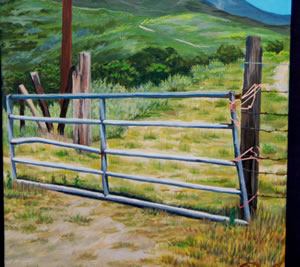
My horse’s hooves crushing the grass with every step and the wind whipping through the dead twigs are the only sounds as we traverse a ridgeline trail high above the city. There is a feeling of peaceful, beautiful loneliness, a welcome isolation, when you simultaneously feel above it all, and yet startlingly insignificant and invisible. My passion for horseback riding, exploring and being in nature provides the unique genesis for my work. The inspiration for this body of work springs from long rides into the “wilderness.” I use this term loosely because there are very few truly wild places left, especially in this sprawling suburban area. This is a profound tragedy and something worth considering, documenting and discussing. My goal is to take the viewer with me on a journey to some of my favorite “wild” places; places which have deep meaning and fond memories. My paintings strive to capture these often unseen landscapes, allowing the viewer a glimpse of places they may never have an opportunity to explore for themselves. In addition, my work investigates mankind’s impact on nature by exploring the interaction between man-made objects, nature, and time. Nature slowly deconstructs human artifacts and reincorporates them into the natural landscape. I attempt to capture this phenomenon of the natural decay of these now abandoned, but once useful things, as well as the ephemeral feelings I experienced at the initial discovery of these lonely objects and forgotten places. [clear]
Evan Kelley

The last two years have seen a large amount of my work focusing on the cultural history of boxing: one of mankind’s oldest yet most vilified sports. The drama of such one-on-one combat is inherent. With the competition exclusively between two individuals, and the brute (or as some would prefer, archaic) skills which value is placed on, issues of race, nationality, religion and even political association have long been brought to the front of discourse, with the boxing match as the vehicle. Throughout its history, boxing has also come under immense scrutiny due to its danger and violence as a form of media entertainment. It is not difficult to locate broadcasted video of a fight in which a fighter dies or is irreparably harmed due to damage in the ring. Some argue that this fact is proof that boxing does not deserve to be deemed a sport and should be made illegal. Defenders of the sport argue that one only need look as far as the news to see far worse violence in equally or even more grandiose depictions. Furthermore, these people argue that boxing provides an opportunity for upward mobility among the dispossessed, who are often victims themselves of predatory managers and promoters. My work for this exhibition investigates the love/hate relationships and seemingly paradoxical views boxing falls under for a media-obsessed, particularly violent-media-obsessed, American society. [clear]
Sarah Lee
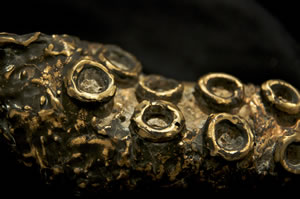
I employ mundane materials that have limited use or are doomed to end up in a landfill and transform them into an artwork that represents the majesty of our natural world. The dichotomy created using discarded materials to represent the purity of nature sparks a conflict of mind for the viewer. I enjoy manipulating material to resemble something of nature without being an exact replica of it. Our creations can never reach the intricate and complex level of nature, but through artistic representation the viewer is encouraged to question the affect of human intervention in this world, especially regarding the changing biosphere and fauna around us. I am greatly influenced by water and the elements of our natural environment. The natural world is extraordinary in its transformative capacity. I believe we have only scraped the surface of astounding life in the ocean and on land and have much more to discover. My work is a commentary on how much influence we have on life we do not even know exists. My work also asks questions and produces wonderment about what we do not know or understand. [clear]
Avery Oatman
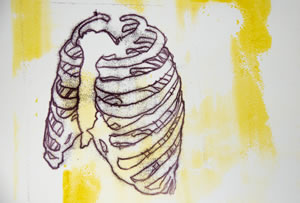
My work explores the paradox between the carefully crafted artwork and one that highlights improvisation and the unconscious. I am inspired by color, texture, energy and rhythm. As a dancer and artist, I work to fuse movement, complex compositional patterns, and an awareness of the body’s anatomical structures into my mixed media work. My passion for art grew out of a yearning to find treasure in odd places and the desire to explore relationships between symbols and their meanings. Linked to themes explored by the readymade and found art, I think art has the capability to distort, comment, recreate, elude, add, deconstruct, and demystify the obscurities and beauty of everyday objects. Inspired by Ferdinand Saussure’s theories on socio-linguistics and the arbitrary nature of words, I experiment with controversial systems of structure and varying modes of analysis and representation. Whether it be combining a digital image with an intaglio print, or working on wood, metal or paper, I am constantly surprised by the versatile and malleable nature of the medium employed in my work. I understand art, not only as a form of individual expression, but as a catalyst for social change that should be made accessible to a range of communities regardless of social and/or economic status. [clear]
Morgan Pepper
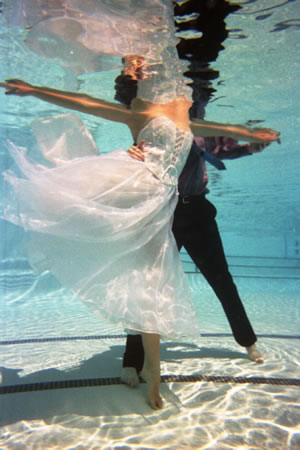
Light and time are encapsulating themes in my work. Underwater photography offers a unique opportunity to distort the appearance of reality through water. This spectacle delves the viewer into suspended gravity and distorted optics. Photography was present throughout my life from an amateur perspective. Before starting college, I participated in a Marine Conservation Project in Thailand, learning ocean conservation and scuba diving. This is where I first got an opportunity to explore underwater photography. While at Pitzer College, this evolved to a more serious compulsion. Nights spent out in nature, I explored ideas concerning the surreal more evident in the dark of night than light of day. Night photography opened the possibility of bending expectations within photography, and through this exploration, surreality in darkness of night lead to an obsession with this phenomenon within underwater photography. My committed participation with the Claremont Colleges Ballroom Dance Company gives me access to another world of fantasy and wonderment. The combination of these themes creates a surreal experience, fusing dance and water into a photographic experience. I use ballroom dancers to exhibit the control and grace of dancing, combined with the surreality of water to create these spectacles. [clear]
Marita Pickron
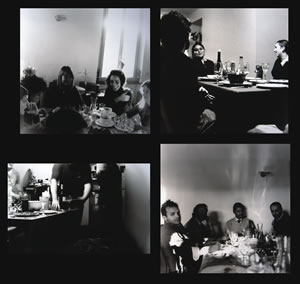
Since elementary school when my mother taught me the very basics of taking a picture with her 35mm SLR, I have become enamored with the process of photographing the world around me. I have always viewed photography as a unique tool enabling me to frame the precise moments, angles and emotions that best capture my understanding and experience of a given instant, rather than simply conveying its physical manifestation. This body of work comprises a series of photographs taken in the past two years while living in the USA, Italy and South Africa. While exploring these distinctly different countries, I was continuously struck by the beauty of socio-cultural particularities in lifestyles, social attitudes and definitions of “norm” that uniquely define daily life in each country. However, I was also very aware from my interactions with passersby and friends that there are some underlying human commonalities—the warmth of sharing a meal with friends and loved ones, music and dance, the desire to explore and learn of the unknown. Although among and even within these countries, the contents of a meal and the definition of family may vary greatly, the underlying actions and motives remain the same. As I explored, listened, and absorbed, I became increasingly aware of common cross-cultural aspirations, experiences and catalysts. I had my camera at the ready and attempted to capture what I perceived as quotidian human experiences in each country—the similar alongside the unique. I hope this collection of jumbled moments and places can inspire the viewer to question their own preconceived notions of “other-ness” as they create for themselves a sense of geographic order in the midst of confusion. [clear]
Kamilla Q. Rifkin
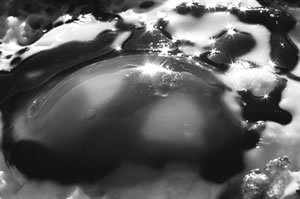
My thesis represents the evolution of food as a theme throughout my work. Food has emerged as a revelatory model for my photography. The elasticity within my subjects—ridged dewy leaves of a red cabbage, gritty millet grains, a brilliantly rubbery albumen of a fried egg—has allowed me to create fantastical landscapes that play with light, shadow, and texture in innovative ways. My work draws inspiration from Edward Weston’s cabbage and bell pepper photos from the 1930s. I am interested in incorporating the practice of dramatizing and eroticizing an inanimate object into my own artwork. From the basic uncooked raw grains on photograms to foods viewed in macro format, I aim to deconstruct the edibles that we are used to seeing on the dinner plate in order to present a new range of images. My goal is to remove each food from immediate recognition, and allow it to reemerge as something more dramatic, massive, abstract. [clear]
Devin von Stade
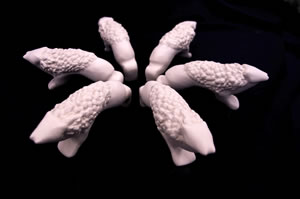
Maine is home. Though I have spent little of the past eight years there, the landscape and its animals have remained a great influenced on my art. Originally a painter idealizing impressionist and surreal works, I spent the past four years working with ceramics. Having previously been hesitant about working in three dimensions, it was a chance to learn anew through play and guidance. Much of my college education was dedicated to the biological sciences with the arts as an outlet for my creativity, and a place to explore my understanding of the natural world. My interest in veterinary medicine, animals and their inherent differences kindles my imagination. I try to create pieces that have a bit of their own life; works that people will want to touch, as well as others that will cause hesitation as if it were an oversized bug. Through this active process, I hope to show a playful development and classification of my ideas, as they have been shaped through my time a Pitzer. Working with clay for the past four years has been inspiring. Given that much of my college education has been dedicated to the sciences, ceramics has allowed me to exercise my creativity. Exploring the development of my ideas, I slip-cast populations of forms and textures influenced by the casting process. Specific aspects that effected how the molds were made were carried through to the next piece I made. With my focused study on anatomy and biomechanics, animals often influence my thought process and guide my work. I try to create pieces that people want to touch, as well as others that might cause hesitation and repulsion, as if it were a live bug, or in the worry that the creature would be skittish. By delving into this obsession, I focused on the string of consciousness that contributes to my artistic process, considering each branch of potential development. Through this living process, I hope to show the playful development and classification of my ideas, as they have been shaped through my time at Pitzer. [clear]
Catalogue – Euan Macdonald
Euan Macdonald: KIMBALL 1901-
January 27 – March 25, 2011
Pitzer Art Galleries, Pitzer College
63 pages, with color and black and white reproductions
ISBN: 978-0-9829956-1-07
Essay by Lisa Gabrielle Mark. Interview by Ciara Ennis
Edited by Kira Poplowski
Catalogue designed by Gabriela Contreras
Worker
Emerging Artist Series #5: James Gilbert & Jennifer Vanderpool
January 27 – March 25, 2011
Lenzner Family Art Gallery
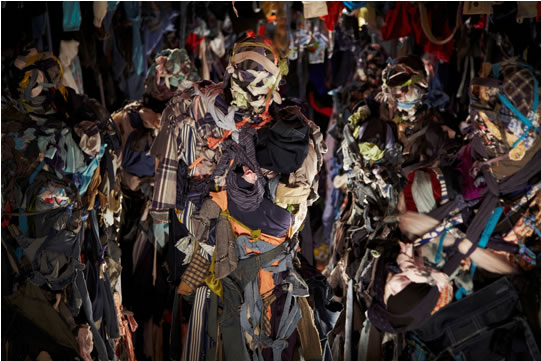 Worker is a performance-based installation that includes sculptural elements, video and audio, creating a powerful visual and aural experience. A group of anthropomorphic life-size soft sculptures are positioned within an undulating organic and visceral environment, created by a mass of used thrift-store and abandoned clothing stacked and layered from floor to ceiling. A cacophonous hum of buzzing bees and chirping birds make up the soundtrack, which is layered against the clattering of sewing machines in the gallery that produce dissonant and competing sounds. Worker pays homage to the artists’ mothers and their innumerable anonymous counterparts who worked in a textile factory in the late 1950s while simultaneously acknowledging Los Angeles garment workers and their collective action to change sweatshop conditions in Los Angeles factories. Worker draws attention to the alienation of contemporary laborers, their invisibility within the process of mass production and the precarious nature of their employment made infinitely worse by the economic downturn. Both organic and industrial, the soundscape creates an enveloping and all-consuming experience providing a charged and meditative space.
Worker is a performance-based installation that includes sculptural elements, video and audio, creating a powerful visual and aural experience. A group of anthropomorphic life-size soft sculptures are positioned within an undulating organic and visceral environment, created by a mass of used thrift-store and abandoned clothing stacked and layered from floor to ceiling. A cacophonous hum of buzzing bees and chirping birds make up the soundtrack, which is layered against the clattering of sewing machines in the gallery that produce dissonant and competing sounds. Worker pays homage to the artists’ mothers and their innumerable anonymous counterparts who worked in a textile factory in the late 1950s while simultaneously acknowledging Los Angeles garment workers and their collective action to change sweatshop conditions in Los Angeles factories. Worker draws attention to the alienation of contemporary laborers, their invisibility within the process of mass production and the precarious nature of their employment made infinitely worse by the economic downturn. Both organic and industrial, the soundscape creates an enveloping and all-consuming experience providing a charged and meditative space.
On opening night, an anthropomorphic sculpture will be created by the artists, Pitzer College students and local participants dressed in repurposed clothes, and material used in the installation symbolically representing the efforts of unseen laborers.
Related Events
Opening Reception: January 27, 5-8 p.m.
Lenzner Family Art Gallery
Panel Discussion: February 10, 2011, 1:15 p.m.
Broad Performance Space, Broad Center, Pitzer College
Panel discussion with artists James Gilbert and Jennifer Vanderpool with Maria Soldatenko, professor of gender and feminist studies/Chicana studies, Pitzer College and Richard Widick, visiting scholar at the Orfalea Center for Global and International Studies, University of California Santa Barbara
 WORLD IS WATCHING – MANIFESTO
WORLD IS WATCHING – MANIFESTO